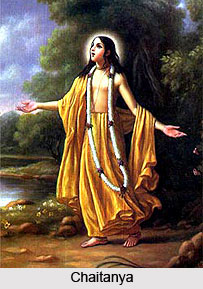 Chaitanya Charitamrita is one of the biographies that explains the teachings and life of Chaitanya Mahaprabhu. Chaitanya was born on the full moon night of February 27, 1486, at the time of a lunar eclipse. He was named by his parents as `Vishvambhar`. He was born in an Utkala Brahmin family in Bengal. In his youth he was known as an erudite scholar. He travelled to Gaya in order to perform the shraddha ceremony for his departed father. There he met his guru, ascetic Isvara Puri, from whom he received initiation with the mantra of Gopal Krishna. This meeting made a significant change in his outlook and upon his return to Bengal the local Vaishnavas were stunned at his sudden `change of heart`. He lost all interest in logic and argument and absorbed himself in chanting Lord Krishna`s names in a devotional ecstasy. Thereafter he became the eminent leader of their Vaishnava group within Nadia district.
Chaitanya Charitamrita is one of the biographies that explains the teachings and life of Chaitanya Mahaprabhu. Chaitanya was born on the full moon night of February 27, 1486, at the time of a lunar eclipse. He was named by his parents as `Vishvambhar`. He was born in an Utkala Brahmin family in Bengal. In his youth he was known as an erudite scholar. He travelled to Gaya in order to perform the shraddha ceremony for his departed father. There he met his guru, ascetic Isvara Puri, from whom he received initiation with the mantra of Gopal Krishna. This meeting made a significant change in his outlook and upon his return to Bengal the local Vaishnavas were stunned at his sudden `change of heart`. He lost all interest in logic and argument and absorbed himself in chanting Lord Krishna`s names in a devotional ecstasy. Thereafter he became the eminent leader of their Vaishnava group within Nadia district.
He left Bengal and received entrance into Sannyasa by Keshav Bharati. Chaitanya journeyed throughout India for several years. He spent the last 24 years of his life in Puri.
Lord Chaitanya was born at a time when India was suffering from extensive self-satisfaction, spiritual stagnation and strict caste stratification. There was a need for change socially, morally, spiritually, politically and intellectually.
He displayed mysterious powers by outmanoeuvred the thieves, played with a poisonous snake and spoke philosophically with his mom. As a student he was brilliant who mastered poetics, Sanskrit grammar and navya nyaya logic. At a young age he opened his own school and taught grammar and logic.
He had travelled to South India and stayed there for four years. Thereafter he went to Prayag, Vrindavan and Varanasi through Bengal for one year. He disappeared from mortal vision at the age of forty-eight in Puri.




















